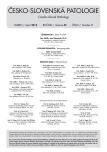Lidské papilomaviry se neúčastní v etiopatogeneze nádorů slinných žláz
Authors:
Alena Skálová 1; Jana Kašpírková 2; Pavel Andrle 3; Lubor Hostička 3; Tomáš Vaneček 2
Authors‘ workplace:
Department of Pathology, Charles University in Prague, Faculty of Medicine in Pilsen, Czech Republic
1; Bioptic Laboratory, Molecular Biology Laboratory, Pilsen, Czech Republic
2; Department of Maxillofacial Surgery, Clinic of Dentistry, Faculty of Medicine in Pilsen, Czech Republic
3
Published in:
Čes.-slov. Patol., 49, 2013, No. 2, p. 72-75
Category:
Original Article
Overview
Onkogenní typy 16 a 18 lidských papilomavirů (HPV z angl. Human Papillomavirus) byly opakovaně prokázány v části dlaždicobuněčných karcinomů v oblasti hlavy a krku. HPV tak představuje prokázaný rizikový faktor v etiopatogenezi části dlaždicových karcinomů orofaryngeální a tonsilární oblasti. Velmi málo je naopak známo o možné roli HPV v nádorech slinných žláz.
Metody.
Na vlastním souboru 55 pacientů s benigními a maligními nádory slinných žláz prezentujeme pokus o detekci biologicky relevantní HPV infekce při využití algoritmu kombinujícího imunohistochemický průkaz proteinu p16 proteinu a molekulárně genetický průkaz HPV DNA pomocí polymerázových řetězových reakcí (PCR) za použití SPF, CPSGB, GP5+/GP6+ primerů, and typově specifických primerů pro detekci HPV 16, 18, 31, 33, 35 a 45.
Výsledky.
Ve skupině 55 tumorů slinných žláz, pouze 5 případů (9 %) bylo zcela negativních na průkaz p16 proteinu a v 10 nádorech se barvilo méně než 25 % nádorových buněk (skóre 1+). Ve většině případů (35/55; 64 %) jsme prokázali silnou jaderně- cytoplasmatickou pozitivitu p16 proteinu v 26 – 50 % nádorových buněk (skóre 2+). V 5 případech (9 %), více než 51 % nádorových buněk exprimovalo p16 protein silně (skóre 3+). Žádný z těchto p16-protein silně pozitivních případů však nevykazoval přítomnost vysoce rizikových onkogenních HPV pomocí PCR.
Závěry.
Výsledky naší studie ukazují, že HPV 16 a 18 nejsou etiologicky asociovány s nádory slinných žláz. Zdá se proto, že exprese p16 proteinu v salivárních nádorech není diagnosticky užitečným zástupným markerem biologicky relevantní transformující infekce HPV.
Klíčová slova:
nádor slinných žláz – HPV – lidský papilomavirus – p16 protein – PCR
Sources
1. Syrjänen S. The role of human papillomavirus infection in head and neck cancers. Ann Oncol 2010; 21 Suppl 7: 243-245.
2. Lewis JS, Thorstad WL, Chernock RD, et al. p16 positive oropharyngeal squamous cell carcinoma: an entity with a favourable prognosis regardless of tumor HPV status. Am J Surg Pathol 2010; 34: 1088-1096.
3. Atula T, Grénman R, Klemi P, Syrjänen S. Human papillomavirus (HPV) and Epstein-Barr virus (EBV) in salivary gland tumors. Clinic Otolaryngol 1998; 23: 471-472.
4. Atula T, Grénman R, Klemi P, Syrjänen S. Human papillomavirus, Epstein-Barr virus, human herpes virus 8 and human cytomegalovirus involvement in salivary gland tumors. Oral Oncol 1998; 34: 391-395.
5. Vageli D, Sourvinos G, Ioannou M, et al. High-risk papillomavirus (HPV) in parotid lesions. Intern J Biol Markers 2007; 22: 239-244.
6. Barnes L, Eveson JW, Reichert P, et al. World Health Organization Classification of Tumours. Pathology and Genetics of Head and Neck Tumours. Lyon, IARC Press, 2005.
7. Tieben LM, ter Schegg et J, Minnaar RP,et al. Detection of cutaneous and genital HPV types in clinical samples by PCR using consensus primers. J Virol Methods 1993; 42: 265-279.
8. de Roda Husman AM, Walboomers JMM, van den Brule AJC, Meijer CJLM, Snijders PJF. The use of general primers GP5 and GP6 elongated at their 3_ends with adjacent highly conserved sequences improves human papillomavirus detection by polymerase chain reaction. J Gen Virol 1995; 76: 1057–1062.
9. van den Brule AJ, Pol R, Fransen-Daalmeijer N, Schouls LM, Meijer CJ, Snijders PJ. GP5+/6+ PCR followed by reverse line blot analysis enables rapid and high-throughput identification of human papillomavirus genotypes. J Clin Microbiol 2002; 40: 779-787.
10. Karlsen F, Kalantari M, Jenkins A, et al. Use of multiple PCR primer sets for optimal detection of human papillomavirus. J Clin Microbiol 1996; 34: 2095-2100.
11. Hagmar B, Johansson B, Kalantari M, Petersson Z, Skyldberg B, Walaas L. The incidence of HPV in a Swedish series of invasive cervical carcinoma. Med Oncol Tumor Pharmacother 1992; 9: 113-117.
12. Pannone G, Santoro A, Papagerakis S, Lo Muzio L, De Rosa G, Bufo P. The role of human papillomavirus in the pathogenesis of head and neck squamous cell carcinoma: an overview. Infectious Agents and Cancer 2011; 6: 4-11.
13. Cantley RL, Gabrielli E, Montebelli F, Cimbaluk D, Gattuso P, Petruzzelli G. Ancillary studies in determining human papillomavirus status in squamous cell carcinoma of the oropharynx: a review. Pathol Research International 2011; Article ID 138469, 7 pages. Doi:10.4061/2011/138469.
14. Seethala RR, Thompson LDR, Gnepp DR, et al. Lymphadenoma of the salivary gland: clinicopathological and immunohistochemical analysis of 33 tumors. Mod Pathol 2012; 25(1): 26-35.
15. Etges A, Nunes FD Ribeiro KC, Araujo VC. Immunohistochemical expression of retinoblastoma pathway proteins in normal salivary glands and in salivary gland tumours. Oral Oncol 2004; 40: 326-331.
16. Patel RS, Rose B, Bawdon H, et al. Cyclin D1 and p16 expression in pleomorphic adenoma and carcinoma ex pleomorphic adenoma of the parotid gland. Histopathology 2007; 51: 691-696.
17. Smeets SJ, Hesselink AT, Speel EJ, et al. A novel algorithm for reliable detection of human papillomavirus in paraffin embedded head and neck cancer specimen. Int J Cancer 2007; 121: 2465-2472.
Labels
Anatomical pathology Forensic medical examiner ToxicologyArticle was published in
Czecho-Slovak Pathology

2013 Issue 2
Most read in this issue
- Nediagnostikovaná Whippleova choroba s letálnym koncom
- Primární velkobuněčný neuroendokrinní karcinom močového měchýře
- Difuzní idiopatická hyperplázie neuroendokrinních buněk: popis případu a přehled literatury
- Nová zárodečná mutace v CYLD genu u slovenského pacienta s Brookeovým-Spieglerovým syndromem
